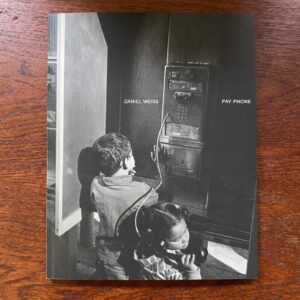JTF (just the facts): A total of 38 color and black-and-white photographs, framed in black/white and matted, and hung against gray walls in the two room gallery space and the entry area. 26 of the works are digital inkjet prints, made between 2002 and 2017. These prints range in size from roughly 7×7 to 20×13 inches. The other 12 works are unique salt prints (some with gold toning) on various handmade papers, made between 1986 and 2015. These prints are sized between roughly 10×6 and 18×12 inches. A catalog of the show is available from the gallery. (Installation shots below, courtesy Pace/MacGill Gallery.)
Comments/Context: At first glance, Emmet Gowin’s grids of colorful moths look like illustrations from a natural history textbook or the exhaustive categorization work of a dedicated entomologist. Set in rigid 5×5 arrays, the small portraits of the mariposas nocturnas (noctural moths) of Central and South America celebrate the extreme diversity of the natural world, each image capturing the unique shape of delicate moth wings or documenting the intricate patterns to be found there. And while these samples exhibit all the rigor of a scientific mind (and likely depict some rare or previously unknown species), they are also the unmistakable work of an artist, whose aesthetic choices and observant attentions turn the overlooked bugs into comparative taxonomies of flying wonder.
Over a span of nearly a decade, Gowin photographed more than a thousand individual moth species, his travels taking him to Bolivia, Brazil, Ecuador, French Guiana, and Panama. Setting up a clear plastic tent in the humid jungle night, he used a bright light to attract the circling moths, which were then quickly caught, photographed, and released while still alive. Each was set against a backdrop of contrasting color, from a hand, a rock, or a tree trunk, to more unexpected settings like reproduced fragments of famous artworks. Gowin’s compositions are all tightly cropped down, but still exhibit a complex sense for color theory and bold combination. They seem to allude to Gerhard Richter’s color charts from the mid-1960s, reconstructing them photographically with colors drawn directly from nature rather than from industrial paint chips.
The apparatus of the transparent tarps also had the indirect effect of providing Gowin with several more flashes of artistic inspiration. When mist and moisture droplets covered the clear plastic, the insects would drag marks across the surface, creating primordial webs of lines and abrasions not unlike the desert tire tracks the artist had photographed from the air some decades earlier. Gowin also found that the artificial light could be used to make unexpected backlit portraits and nudes of his wife Edith. In some, the flare of light illuminates filigrees of bug trails in the air, while in others, it creates dark silhouettes cast through gauzy fabric.
These discoveries seem to have ignited Gowin’s experimental side. Going back to the antiquated process of the tactile salt print, he took his visual learnings and started to push them further. He combined Edith’s face with rain droplets, and posed her in front of the plastic, the silhouettes of winged insects creating a dappled wallpaper behind her. After making a few prints of these subjects, he turned the iterative crank further and proceeded to make paper cutouts of various figures, which he then used to create see-through black silhouettes by pressing them against the plastic. Using this blocking technique, he made a selection of gestural scenes using the cutouts in different ways, and then introduced the forms of bed springs, leaves, and hardware inside (or interrupting) the outlines, the shadowy toning giving each image a moody sense of mystery. The pictures have the real sense of boundaries being blurred, of memories dissolving into each other and moments becoming pared down and stylized. Out in the jungle, even after so many years, Emmet and Edith seem to have found each another yet again, with echoes of images past coming through in new interactions.
Between the graceful aging of Edith’s body, the toxin stains left by the moths, the fragments of memory unearthed, and the rhythms of darkness and light or rain and sun, the entirety of Gowin’s new work feels deeply rooted in the cycles of nature and the undulations of life. Mostly, the pictures feel patient and attentive, in ways that encourage the pace of life to slow down just enough so that its nuances can be seen and felt more deeply. The genuine warmth, and love, and affectionate curiosity of Gowin’s vision is still there, his desire to keep looking seemingly unquenched by the passing of time.
Collector’s POV: The works in this show are priced between $4500 and $45000. Gowin’s work has only been intermittently available in the secondary markets in recent years, with just a handful of prints coming up for sale in any given year. Recent prices for single images have ranged from roughly $1000 to $10000, with portfolios and multi-print sets reaching $40000.













